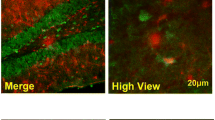Abstract
Vascular disruptions including blood–brain barrier breakdown and pathologic angiogenesis contribute to the development of epilepsy in normal brains. The Notch signaling pathway is activated in response to seizure activity, and its activation promotes seizures, although its exact role in angiogenesis is poorly understood. Here, we have examined the role of Notch signaling in angiogenesis in a kainic acid-induced mouse model of epilepsy. We show that following seizures, expression of the Notch ligand Jagged1 in the hippocampus is upregulated in astrocytes and levels of activated Notch1 are increased in endothelial cells. Using an in vitro model of angiogenesis, we provide evidence that brain endothelial tube formation is promoted in the presence of astrocytes. Isolated primary brain endothelial cells develop significantly longer vascular sprouts when cultured in the presence of astrocytes. Notch1 signaling is activated in brain endothelial cells cocultured with astrocytes, and astrocytic Jagged1 expression is required for angiogenic enhancement, as shown by the inhibitory effect of Jagged1 small interfering RNA (siRNA) expression in astrocytes on endothelial cell vascular sprouting in vitro. Therapies targeting the Jagged1/Notch1 signaling pathway may therefore be effective in limiting aberrant angiogenesis following status epilepticus.






Similar content being viewed by others
References
Morin-Brureau M, Rigau V, Lerner-Natoli M (2012) Why and how to target angiogenesis in focal epilepsies. Epilepsia 53(Suppl 6):64–8
Ndode-Ekane XE, Hayward N, Gröhn O, Pitkänen A (2010) Vascular changes in epilepsy: functional consequences and association with network plasticity in pilocarpine-induced experimental epilepsy. Neuroscience 166(1):312–32
Marcon J, Gagliardi B, Balosso S, Maroso M, Noé F, Morin M, Lerner-Natoli M, Vezzani A et al (2009) Age-dependent vascular changes induced by status epilepticus in rat forebrain: implications for epileptogenesis. Neurobiol Dis 34(1):121–32
Newton SS (2003) Gene profile of electroconvulsive seizures: induction of neurotrophic and angiogenic factors. J Neurosci 23(34):10841–10851
Marchi N (2010) Blood–brain barrier damage, but not parenchymal white blood cells, is a hallmark of seizure activity. Brain Res 1353:176–186
Marchi N (2011) The etiological role of blood–brain barrier dysfunction in seizure disorders. Cardiovasc Psychiatry Neurol 2011:482415
Tomkins O, Shelef I, Kaizerman I, Eliushin A, Afawi Z, Misk A, Gidon M, Cohen A et al (2008) Blood–brain barrier disruption in post-traumatic epilepsy. J Neurol Neurosurg Psychiatry 79(7):774–7
Marchi N, Angelov L, Masaryk T, Fazio V, Granata T, Hernandez N, Hallene K, Diglaw T et al (2007) Seizure-promoting effect of blood–brain barrier disruption. Epilepsia 48(4):732–42
Fabene PF, Navarro Mora G, Martinello M, Rossi B, Merigo F, Ottoboni L, Bach S, Angiari S et al (2008) A role for leukocyte-endothelial adhesion mechanisms in epilepsy. Nat Med 14(12):1377–83
Stanimirovic DB, Friedman A (2012) Pathophysiology of the neurovascular unit: disease cause or consequence & quest. J Cereb Blood Flow Metab 32(7):1207–1221
Abbott NJ, Rönnbäck L, Hansson E (2006) Astrocyte-endothelial interactions at the blood–brain barrier. Nat Rev Neurosci 7(1):41–53
Cabezas R, Avila M, Gonzalez J, El-Bachá RS, Báez E, García-Segura LM, Jurado Coronel JC, Capani F et al (2014) Astrocytic modulation of blood brain barrier: perspectives on Parkinson’s disease. Front Cell Neurosci 8:211
Ables JL et al (2011) Not (ch) just development: notch signalling in the adult brain. Nat Rev Neurosci 12(5):269–283
Phng LK, Gerhardt H (2009) Angiogenesis: a team effort coordinated by notch. Dev Cell 16(2):196–208
Li F, Lan Y, Wang Y, Wang J, Yang G, Meng F, Han H, Meng A et al (2011) Endothelial Smad4 maintains cerebrovascular integrity by activating N-cadherin through cooperation with notch. Dev Cell 20(3):291–302
Sha L, Wu X, Yao Y, Wen B, Feng J, Sha Z, Wang X, Xing X et al (2014) Notch signaling activation promotes seizure activity in temporal lobe epilepsy. Mol Neurobiol 49(2):633–44
Racine RJ (1972) Modification of seizure activity by electrical stimulation. II. Motor seizure. Electroencephalogr Clin Neurophysiol 32(3):281–94
Holcik M (2000) The hippocampal neurons of neuronal apoptosis inhibitory protein 1 (NAIP1)-deleted mice display increased vulnerability to kainic acid-induced injury. Proc Natl Acad Sci 97(5):2286–2290
Pellerin L, Magistretti PJ (1994) Glutamate uptake into astrocytes stimulates aerobic glycolysis: a mechanism coupling neuronal activity to glucose utilization. Proc Natl Acad Sci 91(22):10625–10629
Nakatsu M, Jaeger D, Christopher H (2007) Optimized fibrin gel bead assay for the study of angiogenesis. J Vis Exp 3:186
Rigau V, Morin M, Rousset MC, de Bock F, Lebrun A, Coubes P, Picot MC, Baldy-Moulinier M et al (2007) Angiogenesis is associated with blood–brain barrier permeability in temporal lobe epilepsy. Brain 130(Pt 7):1942–56
Ben-Ari Y (1985) Limbic seizure and brain damage produced by kainic acid: mechanisms and relevance to human temporal lobe epilepsy. Neuroscience 14(2):375–403
Haseloff RF (2005) In search of the astrocytic factor(s) modulating blood–brain barrier functions in brain capillary endothelial cells in vitro. Cell Mol Neurobiol 25(1):25–39
Bell RD (2010) Pericytes control key neurovascular functions and neuronal phenotype in the adult brain and during brain aging. Neuron 68(3):409–427
Marchi N, Lerner-Natoli M (2013) Cerebrovascular remodeling and epilepsy. Neuroscientist 19(3):304–312
Croll SD, Goodman JH, Scharfman HE (2004) Vascular endothelial growth factor (VEGF) in seizures: a double-edged sword. Adv Exp Med Biol 548:57–68
Argaw AT (2012) Astrocyte-derived VEGF-a drives blood–brain barrier disruption in CNS inflammatory disease. J Clin Invest 122(7):2454
Zlokovic BV (2008) The blood–brain barrier in health and chronic neurodegenerative disorders. Neuron 57(2):178–201
Carmeliet P, Jain RK (2011) Molecular mechanisms and clinical applications of angiogenesis. Nature 473(7347):298–307
Bray SJ (2006) Notch signalling: a simple pathway becomes complex. Nat Rev Mol Cell Biol 7(9):678–689
Acknowledgments
This work was supported by grant 2009-2-264 from Chongqing Municipal Health Bureau Research Fund, grant cstc2012gg-yyjs0838 from Chongqing Science and Technology Commission scientific and technological projects, and the Chongqing Natural Science Foundation (2008-4-174).
Conflict of Interest
The authors declare no conflict of interest.
Author information
Authors and Affiliations
Corresponding authors
Rights and permissions
About this article
Cite this article
Zhai, X., Liang, P., Li, Y. et al. Astrocytes Regulate Angiogenesis Through the Jagged1-Mediated Notch1 Pathway After Status Epilepticus. Mol Neurobiol 53, 5893–5901 (2016). https://doi.org/10.1007/s12035-015-9492-8
Received:
Accepted:
Published:
Issue Date:
DOI: https://doi.org/10.1007/s12035-015-9492-8




